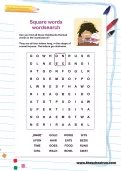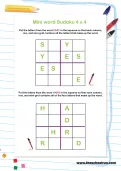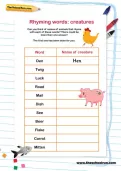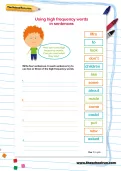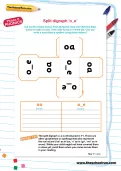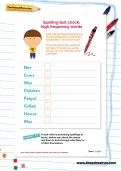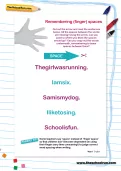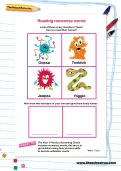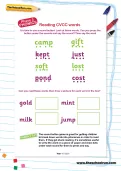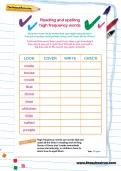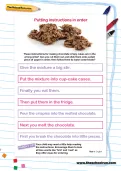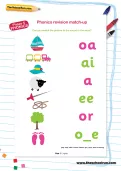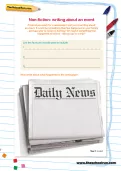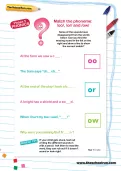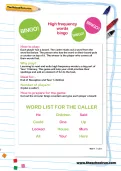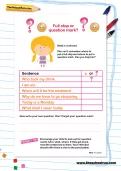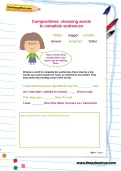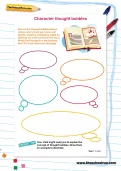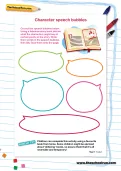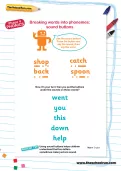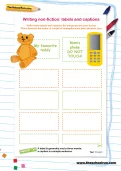Here is a Year 1 high frequency words activity, created by an educational expert. Can you read the high frequency words? Write four sentences. In each sentence try to use two or three of the high frequency words.
or
Register to add to your saved resources
Already a subscriber? to view this content.
Cut out the shape below. Fold along the lines and stick the flaps down to make a cube. Then take turns to roll the die. Can you write a word that is spelled using those letters?
or
Register to add to your saved resources
Already a subscriber? to view this content.
Jack has just finished preparing for his spelling test. Look at these words – how did he do? Put a tick next to the words he got right. If he got any words wrong, can you write the word correctly?
or
Register to add to your saved resources
Already a subscriber? to view this content.
Cut out the shape below. Fold along the lines and stick the flaps to make a cube. Then roll your word die and write down a sentence with that word in it. Don’t forget capital letters and full stops! Get
your mum and dad to have a go too! Who can write the silliest sentence?
or
Register to add to your saved resources
Already a subscriber? to view this content.
Cut out the arrow and read the sentences below. All the spaces between the words are missing! Using the arrow, can you point to where you think the spaces should go? Can you copy out the words underneath, remembering to leave spaces between them?
or
Register to add to your saved resources
Look at these scary monsters! Yikes!! Can you read their names?
or
Register to add to your saved resources
Already a subscriber? to view this content.
It’s time to use a sound button! Look at these words. Can you press the button under the sounds and say the sound? Then say the word.
or
Register to add to your saved resources
Already a subscriber? to view this content.
Here are some tricky words that you might already know. Can you practise writing them using Look Cover Write Check?
or
Register to add to your saved resources
Already a subscriber? to view this content.
These instructions for making chocolate crispy cakes are in the wrong order! Can you cut them out and stick them onto a plain piece of paper in order, then follow them to make some treats?
or
Register to add to your saved resources
Already a subscriber? to view this content.
Can you match the picture to the sound in the word?
or
Register to add to your saved resources
Already a subscriber? to view this content.
Pretend you work for a newspaper and you’re writing about an event. It could be something that has happened in your family – perhaps you’ve been on holiday? Or maybe something that happened at school – did you go on a trip?
or
Register to add to your saved resources
Already a subscriber? to view this content.
A glossary is sometimes found in the back of a non-fiction book. It explains what words mean. Have a go at completing this glossary!
or
Register to add to your saved resources
Some of the sounds have disappeared from these words. Can you find the missing sound in the list on the right and draw a line to show the correct match?
or
Register to add to your saved resources
Already a subscriber? to view this content.
This game will help your child practise their spellings and add an element of fun to the task.
or
Register to add to your saved resources
Already a subscriber? to view this content.
Bella can’t remember where to put a full stop and where to put a question mark. Can you help her?
or
Register to add to your saved resources
Already a subscriber? to view this content.
Choose a word to complete the sentences; there may be a few words you could choose for each, so whichever you prefer!
or
Register to add to your saved resources
Already a subscriber? to view this content.
Using a story book you know well decide what the characters might be thinking at certain points in the story. Write their thoughts in the bubbles, then Blu Tack them onto the page.
or
Register to add to your saved resources
Already a subscriber? to view this content.
Using a story book decide what the characters might say at certain points in the story. Write their words in the speech bubbles.
or
Register to add to your saved resources
Already a subscriber? to view this content.
Learn about phonemes: press the button and say the sound, then say the word.
or
Register to add to your saved resources
Already a subscriber? to view this content.
Write some labels and captions for things around your house. Place them on the items. Remember: a label is generally one to three words; a caption is a simple sentence.
or
Register to add to your saved resources
Already a subscriber? to view this content.
